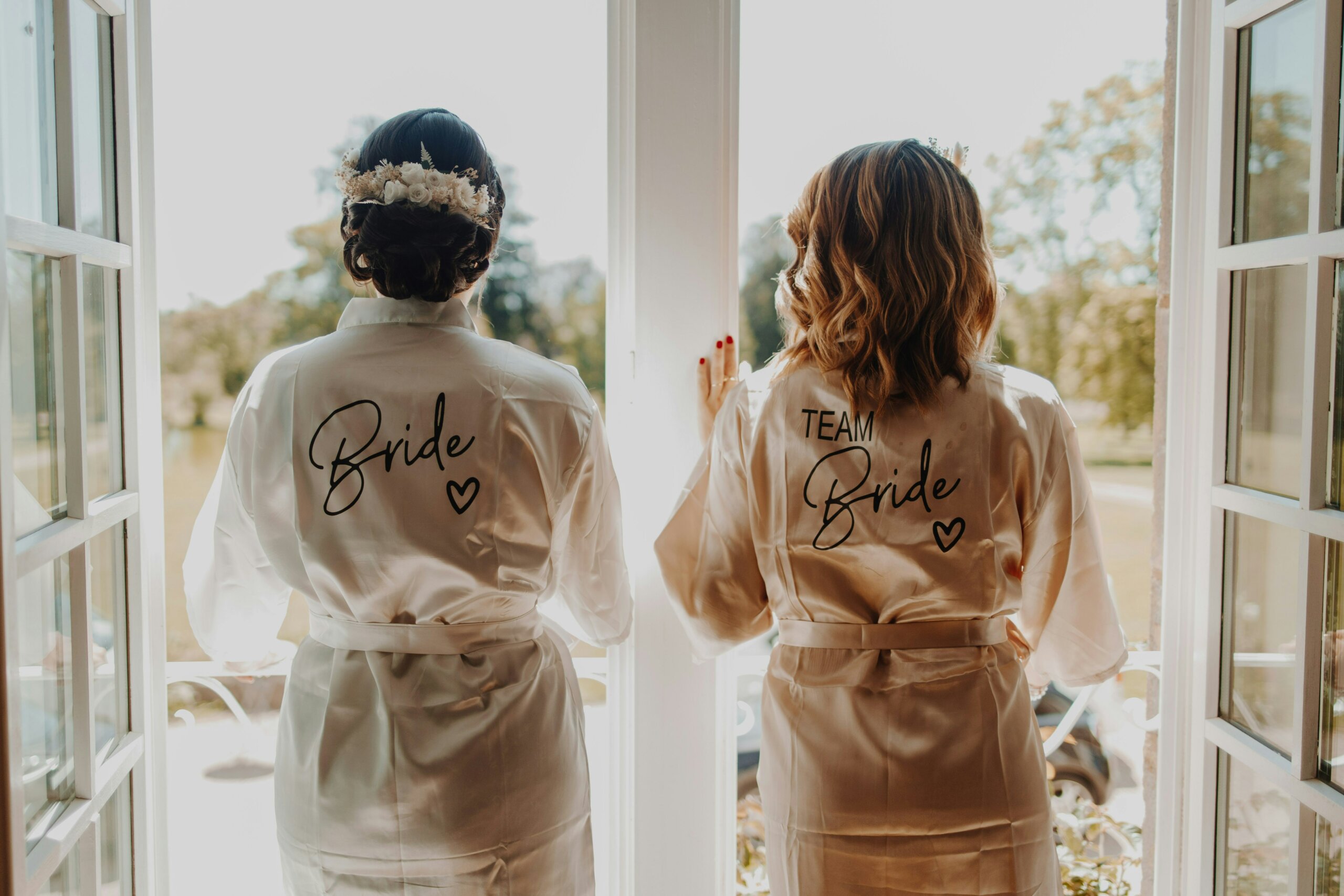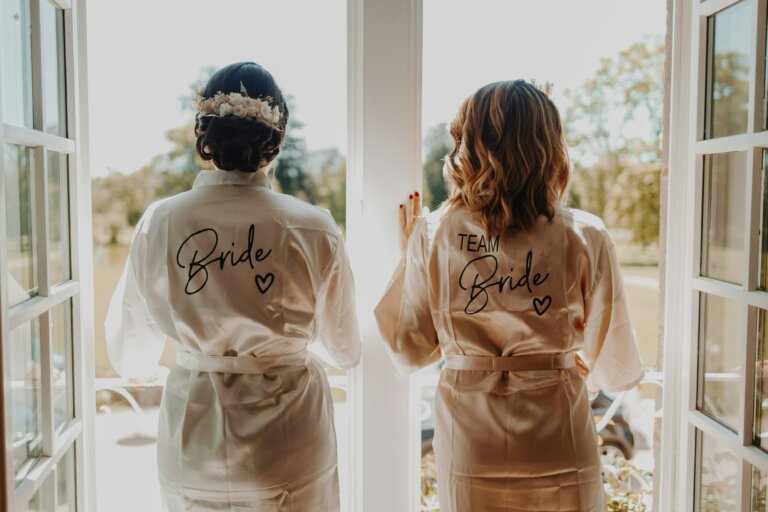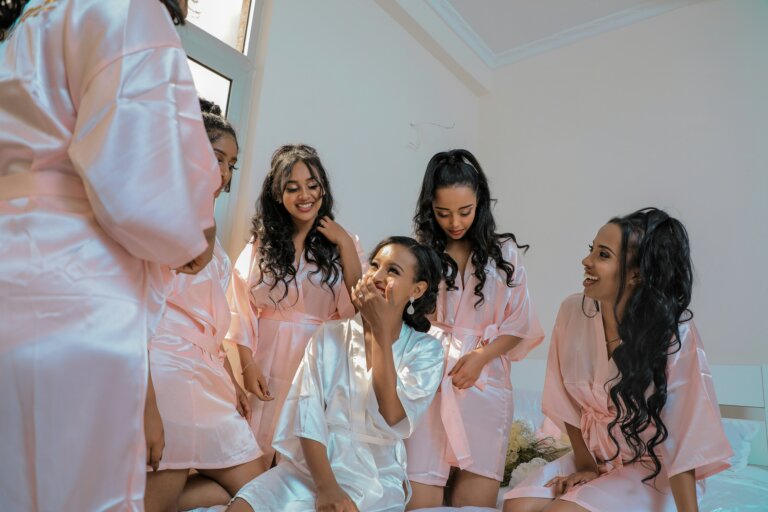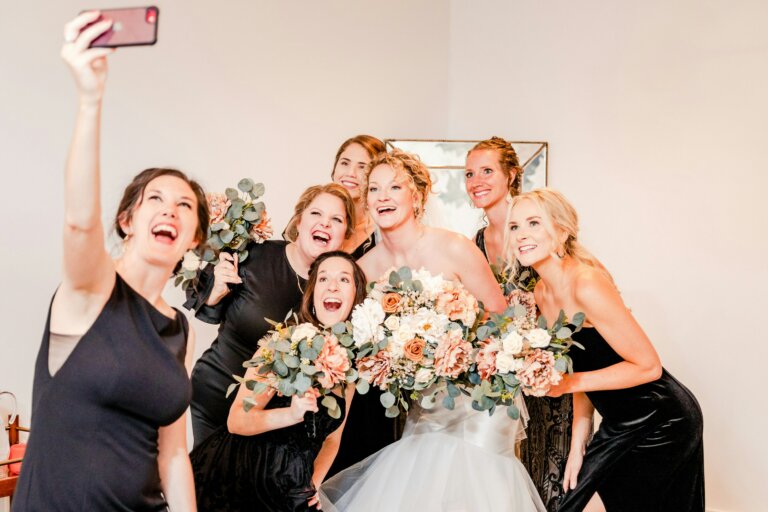Maid of Honour Duties: Your Complete Guide & Wedding Day Timeline

Believe it or not, but the maid of honour’s duties once involved protecting the bride from evil spirits. What started as an ancient protector role has transformed into a modern-day wedding coordinator position that remains just as important. The chief bridesmaid now does everything from organising pre-wedding celebrations to managing last-minute emergencies on the big day.
Responsibilities go way beyond the reach and influence of standing beside the bride at the altar. You’ll help select her perfect dress, coordinate with vendors and prepare that essential reception speech. These tasks might seem daunting, since the maid of honour handles more responsibilities than other bridesmaids.
We’ve created this complete guide to help you navigate every aspect of your duties – right from the moment you’re asked until the last dance at the reception. Together, we’ll make sure you become the support system your bride needs!
What is a maid of honour?
The maid of honour is the chief bridesmaid, usually either the bride’s best friend or sister, responsible for leading all the bridal party tasks and supporting the bride in every which way she needs or asks.
The role began in royal courts where young noblewomen worked as junior attendants to queens. Noble families sent their unmarried daughters, usually sixteen or older, to serve in these positions.

Traditional role and meaning
Ancient civilisations started the tradition of having a maid of honour. Hebrew culture called the bride’s female companion ‘kalat’. Similarly, in ancient Greece, the bride has a female attendant, though the name didn’t become ‘demoiselle d’honneur’ until the French so named it. Later on in history, royal households used such maid of honour positions as finishing schools for young noblewomen. The role helped them find good marriage matches.
The position held great prestige in royal courts. Queen Elizabeth I had six maids of honor at her coronation ceremony. European royal courts kept this tradition alive. These maids received several benefits like housing, food and sometimes even payment, which just goes to show how sought-after it became.
Modern responsibilities
Today’s maid of honour acts as the bride’s main support system. The role combines both ceremony duties and practical help. This position has changed from its historical beginnings to focus more on wedding planning and emotional support.
Brides usually pick their maid of honour from their closest friends – often their sister, best friend or a close relative. The perfect candidate needs both organisation skills and emotional understanding. Here are the main parts of the job:
Lead the bridal party activities
Provide emotional support throughout planning
Coordinate pre-wedding celebrations
Assist with wedding day logistics
Serve as the bride’s trusted advisor
The difference between ‘maid’ and ‘matron’ of honor remains today – unmarried women serve as maids of honor, while married women become matrons of honor. On top of that, modern couples now adapt these traditional roles to fit their needs. Some choose gender-neutral titles like ‘person of honor’ or ‘best friend of honor’. For more information on this, check out our dedicated article on gender-neutral and inclusive wedding terms.
First steps after being asked by the bride
That special “Will you be my maid of honor?” request starts an exciting trip. Research shows about 75% of first-time maids of honour experience mixed feelings of excitement and uncertainty about their new role.

The first talk with the bride
The maid of honour’s first step after accepting this honour is to schedule a detailed talk with the bride, with a focus on understanding how to best support her through the wedding planning process. Be sure to ask specific questions about her vision for pre-wedding celebrations and find out if she wants traditional parties or intimate gatherings.
Setting expectations
Clear boundaries and expectations help prevent conflicts later. Talk about your availability for wedding activities and be upfront about your budget limits. If any responsibilities feel overwhelming, speak up early – most bride-maid of honor conflicts happen because of poor communication about duties.
A shared Google Drive document or group chat will help keep everyone connected. This system makes it easier to work with other bridesmaids and keeps communication flowing throughout the planning.
Creating a planning timeline
A well-laid-out timeline will give you a clear path for the months ahead. Here’s a practical way to create your timeline:
Immediate tasks (1-2 months after engagement):
Meet with the bride to discuss her vision
Start a communication system with bridesmaids
Begin researching vendors and venues
Mid-term planning (3-6 months before wedding):
Schedule dress fittings
Plan pre-wedding celebrations
Coordinate with other bridesmaids
Final preparations (1-2 months before wedding):
Confirm all arrangements
Create detailed day-of schedule
Prepare emergency kit
Regular check-ins with the bride are vital throughout this process. Some brides like to delegate tasks directly, while others appreciate periodic check-ins and offers of support. You should adjust your approach based on the bride’s personality and priorities.
Pre-wedding maid of honour planning duties
Helping the bride find her perfect dress ranks among your most important duties as maid of honor. Research shows brides generally need multiple shopping trips, which makes you a vital part of their support system.
Dress shopping assistance
Your main duty involves showing up for wedding dress appointments and giving honest, constructive feedback. Note that you should take photos of dresses (with permission) or keep detailed notes about styles and designers. This documentation helps the bride review her options later and share them with family members who couldn’t attend.
Your role goes beyond the original shopping phase. You should attend dress fittings and help coordinate accessories, including shoes and undergarments. You’ll need to become skilled at helping the bride in and out of her dress since this skill becomes essential on the wedding day.
Coordinating with bridesmaids
Your leadership role means you’ll oversee bridesmaid dress coordination. This task requires attention to several factors:
Budget considerations for each bridesmaid
Colour selection that complements skin tones
Style options based on the bride’s vision
Timeline management for orders and alterations
Clear communication channels must stay open with these responsibilities. Research shows that a group chat or shared document helps streamline coordination among bridesmaids. The process also needs a 5-6 month cushion for bridesmaid dress orders to allow time for alterations and possible returns.
The bride’s parameters deserve respect during attire coordination. Some brides give specific guidelines, while others allow flexibility in dress selection. You’ll need to balance these priorities with practical considerations, such as keeping proper undergarments hidden and coordinating timely dress fittings.
Dress fittings need early scheduling before the wedding date. Clear communication about financial responsibilities is key – bridesmaids usually cover their dress costs, shoes and accessories unless the bride indicates otherwise. Check out our dedicated guide on what bridesmaids should and shouldn’t pay for to learn the traditional breakdown of payments.
Organising pre-wedding events
Pre-wedding celebrations are the life-blood of your maid of honour duties. These events need careful planning and attention to detail that matches the bride’s vision perfectly while taking into account practical considerations.

Planning the hen party
We recommend starting the hen party planning 3-6 months before the wedding. Your first step is to ask the bride about her priorities – some want a wild celebration while others prefer a more relaxed gathering. Once you know her vision, create a detailed timeline and budget that works for everyone attending.
These elements will help you create a successful hen party:
Venue selection based on group size and activities
Clear communication about costs and expectations
Buffer time between scheduled activities
Contingency plans for unexpected changes
A budget that works for all guests
You should avoid packing too many activities into the day. Leave at least 30 minutes between activities for delays or quick changes. On top of that, get all payments upfront to skip awkward money talks during the celebration.
Arranging bridal shower
The bridal shower usually happens 2-8 weeks before the wedding. Your first step should be to work with family members and other bridesmaids to pick the host, since modern etiquette lets anyone close to the bride organise this celebration.
The bridal shower should reflect the bride’s personality. A high tea setting often works beautifully, with elegant touches like vintage china and fresh flower arrangements. You might want to try unique themes that line up with the bride’s interests, such as her favourite books or TV shows.
Your food and drink menu should balance alcoholic and non-alcoholic options. A dessert buffet doubles as decoration and refreshment, while carefully chosen finger foods meet everyone’s dietary needs.
It’s worth mentioning that you should capture these special moments. Set up a photo area with good lighting and maybe even a themed backdrop. This extra touch creates memories the bride will treasure after her wedding day.
The pre-wedding events really need open communication between the bride and guests. Send invitations 4-6 weeks early, and spell out any costs, dress codes or special requirements clearly. Your main goal is to make the bride feel special and loved, rather than following a social-first approach.
Wedding day morning timeline
A well-laid-out timeline will give a smooth wedding morning. Research shows that good planning helps reduce stress levels by 60% on the wedding day.

The getting ready schedule
We planned backwards from the ceremony time. Hair and makeup should begin 6 hours before the ceremony. The strategic breakdown looks like this:
Hair styling: 60-90 minutes for bride, 30-45 minutes per bridesmaid
Makeup application: 45-60 minutes for bride, 30-45 minutes per bridesmaid
Dress preparation: Allow 45 minutes for the bride to get dressed
Bridesmaids can start with their own hair appointments first while the bride begins with makeup. This setup optimises efficiency and keeps everyone looking fresh throughout the day, though of course check with the bridal beauty team that this aligns with their ways of working and needs. For a full guide to the perfect wedding day timeline, check out our article on the topic.
Managing the bridal party
Clear communication about the timeline with all attendants comes first. The bridal party needs clear direction and regular check-ins. Everyone should know their roles and responsibilities right after arrival.
Hydration is vital – wedding days bring plenty of Champagne but never enough water. Small breaks between activities help with refreshments and touch-ups.
The timeline might seem strict, but extra buffer time helps. Studies show that adding 15 extra minutes helps maintain schedule flexibility. Progress monitoring and adjustments can happen as needed.
Bridal emergency kit essentials
The maid of honour’s secret weapon against unexpected situations is a well-stocked bridal emergency kit. The supplies fall into these categories:
Style and safety supplies:
Hairspray, brush, bobby pins
Fashion tape, safety pins
Sewing kit with scissors
Stain remover and lint roller
Clear nail polish
Health and comfort items:
Pain relievers
Antacid tablets
Blister protection
Feminine products
Hand sanitiser
Fresh and clean necessities:
Deodorant
Mints/mouthwash
Tissues
Makeup remover
Oil blotting papers
A smaller version of this kit can stay in the toilets for guests. Travel-sized items work best, with focus on multi-purpose products – to name just one example, deodorant prevents both perspiration and shoe blisters.
Ceremony and reception duties
Being next to the bride on her special day is the highlight of your maid of honour experience. From seating plans to music arrangements, your role will hugely affect the ceremony and reception, which helps create special moments.

Ceremony responsibilities
The wedding party’s processional order needs your attention first. Tradition calls for bridesmaids to walk down the aisle one by one, followed by flower girls and page boys just before the bride. As the maid of honour, you need to make sure everyone knows their positions and timing.
Your ceremonial duties include these important tasks:
Bouquet management: Hold the bride’s bouquet during vow exchange
Ring safekeeping: Keep the wedding ring(s) safe when entrusted to you
Marriage license: Sign as an official witness with the best man
Dress and veil Arrangement: Keep the bride’s attire perfect throughout
Emergency kit access: Have essential items ready
Your presence offers both practical support and emotional comfort to the bride on her special day. You will stand closest to her and help with any unexpected needs that might arise during the ceremony.
Reception tasks
The wedding reception brings new responsibilities that need organisation and energy. The maid of honour duties go beyond just celebrating:
Speech preparation and delivery: Make your maid of honour speech heartfelt but brief. Share meaningful stories about the bride while avoiding awkward topics or crude humor. Practice your speech beforehand to deliver it smoothly.
Dancefloor management: Following in the wake of the newlyweds’ first dance, you and the best man should encourage guests to join in. This helps keep the reception’s energy high and ensures everyone has fun.
Guest coordination: Your duties here include:
Showing guests to their seats
Managing guest book signatures
Answering questions about gifts
Helping with photo coordination
Bride’s comfort: Keep an eye on the bride’s needs:
Make sure she drinks enough water
Help her with toilet visits
Work with suppliers on event timing
Handle any unexpected issues
Gift Organisation: Work with other bridesmaids to:
Keep wedding gifts safe
Track cards and envelopes
Transport presents
Protect valuable items
Stay in touch with the wedding coordinator or venue manager about the timeline. This helps create smooth transitions between reception activities, from dinner service to cake cutting.
The maid of honour’s role combines visible duties like speeches and leading dances with behind-the-scenes support. Your attention to detail and organisation lets the newlyweds enjoy their special day without worrying about logistics.
Conclusion
A maid of honour must show dedication, stay organised and truly care about the bride’s vision. Your role combines hands-on support with emotional guidance throughout the wedding experience. Clear communication with the bride and wedding party ensures the smooth execution of all responsibilities.
You need to stay organised with timelines, checklists and emergency preparations to handle both planned activities and unexpected situations confidently. On top of that, this helps create a stress-free experience when you keep open communication with bridesmaids, suppliers and family members.
Your presence and support will mean everything to the bride during this special time. Be her trusted confidante and coordinator while helping create beautiful memories that she’ll treasure forever.
The perfect celebration needs expert wedding advice and planning support. Here at Bridebook, you’ve got to access detailed planning tools and guidance that will help you excel in your role as maid of honour.

FAQs
Q1. What are the main responsibilities of a maid of honour on the wedding day? The maid of honour plays a crucial role on the wedding day, assisting the bride with getting dressed; managing the bridal party; holding the bride’s bouquet during the ceremony; and helping with various reception tasks such as giving a speech and coordinating with suppliers.
Q2. How far in advance should a maid of honour start planning pre-wedding events? We recommend that you start planning pre-wedding events like the hen party and bridal shower 3-6 months before the wedding. This allows ample time for coordination, invitations and addressing any potential scheduling conflicts.
Q3. What should be included in a wedding day emergency kit? A well-prepared emergency kit should include style and safety supplies (like hairspray and safety pins), health and comfort items (such as pain relievers and blister protection), and fresh and clean necessities (including deodorant and oil blotting papers). For a full breakdown, see our wedding survival kit guide.
Q4. How can a maid of honour help manage the wedding day timeline? The maid of honour can assist in managing the wedding day timeline by creating a detailed schedule for getting ready; coordinating with the bridal party; ensuring everyone stays on track; and building in buffer time to handle unexpected delays.
Q5. What are some key duties of a maid of honour during the wedding reception? During the reception, the maid of honour’s duties include delivering a speech to toast the newlyweds; encouraging guests to participate in dancing; assisting with guest coordination; ensuring the bride’s comfort; and helping organise and secure any wedding gifts.
You Might Also Like…
- Top 12 Maid of Honour Speech Examples
- The Best Wedding Day Timeline
- The Ultimate Wedding Planning Checklist
- What Your Bridesmaids Should and Shouldn’t Pay For
- Gender-Neutral and Inclusive Wedding Terms

